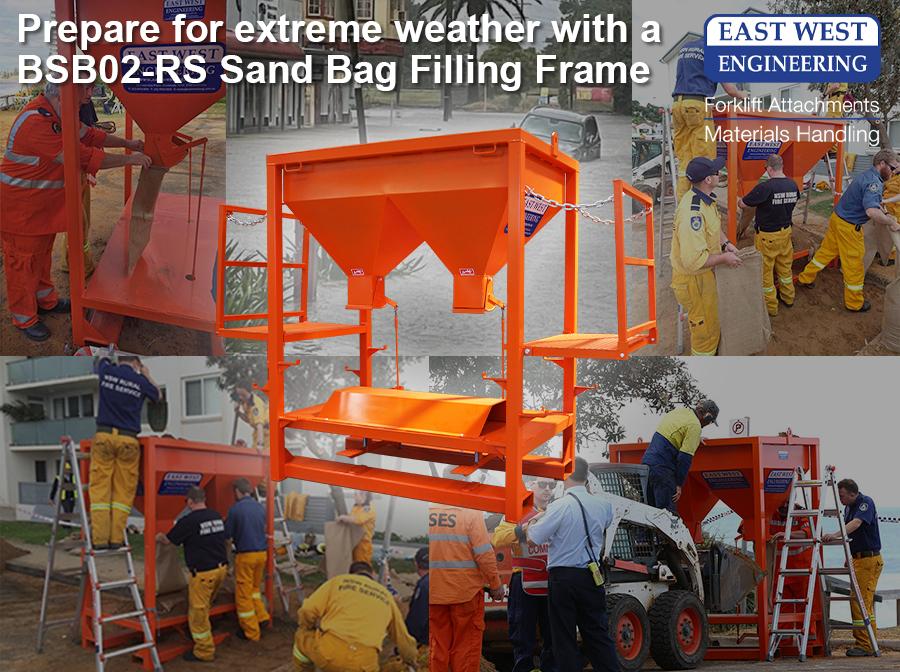-
PRODUCTS
- Forklift Attachments
- Work Platforms
- Goods Cages & Platforms
- Order Picking Cages
- Forks (extension, hydraulic...)
- Forklift Jibs
- Drum Handling
- Cable Drum Handling
- Fork & Tarp Spreaders
- Roll Prongs
- Dirt Buckets & Blades
- Bin Tippers
- Bin Rotator Base
- Forklift Bins
- Bin Compactor
- Container Ramps
- Rotators
- Bale Clamps
- Sideshifts & Fork Positioners
- Load Guards
- Grab Attachment
- Forklift Accessories
- Hydraulic Attachments
- Crane & Overhead Lifting
- Drum Handling & Storage
- Waste & Storage Bins
- Stillage Cages & Trolleys
- Bulk Material Handling
- Concrete Equipment
- Site & Workshop Equipment
- Lifters & Tilters
- Gas Cylinder Handling & Storage
- Telehandler
- Excavator
- Agriculture: Tractor & Loader
- Customs & Specialised Handling
- What's NEW
- Forklift Attachments
- ABOUT US
- CONTACT US
Prepare for extreme weather with a Sand Bag Filling Frame

With La Niña causing havoc across eastern Australia, many local communities are working hard to protect themselves from the risk of flood caused from the largest rainfall ever recorded since records began in 1859.
The local community tends to pull together to help but without the forward planning, guidance and organisation of local councils, State Emergency Services (SES) and the Rural Fire Services (RFS) preparations can easily fall wayside.
There are many strategies used by local governments to reduce flood damage, however the most common weapon that can be carried out by anyone is the sandbag.
Sandbagging has been around for centuries. It is a simple, but effective way to prevent or reduce flood water damage by acting as a barrier to divert moving water around, instead of going through buildings.
Whilst its construction does not guarantee a water-tight seal, the sand inside catches fine particle like silt and clay, found in flood waters, to build a better barrier against water flowing through the sandbag. As more water flows through, the sand gets muddier, so less water seeps through the bag.
Sandbags are also used successfully to prevent overtopping of streams with levees, and for training current flows to specific areas.
Though manually filling sandbags is the easiest and least expensive method, it's also the most time-consuming. Manual filling requires one person to hold the bag open and the second person adding sand to the bag.
In an emergency situation, time is certainly of the essence. Automated options like sandbag filling frames exist for times when you need to quickly produce a substantial number of sandbags.
Sandbag Filling Frames such as East West Engineering’s BSB02-RS are designed to increase efficiency while reducing the hard work and risk of injury associated with manual bag filling. Ideal for councils, emergency services, civil work contractors, builders and landscapers, their gravity fed unit enables the filling of an 18kg bag approximately every 6-8 seconds.
Simple to operate and requiring no power source to function, the BSB02-RS includes dual outlets to allow two operators to work simultaneously for double the output of sandbags and comes with foldable side platforms for safe access and loading.
“Back in 2016, when huge waves and king tides pummelled the NSW coastline, one of our Sandbag Filling frames was supplied to help support the RFS and local community at Collaroy beach with their sand bagging efforts.” said East West Engineering owner, Ron King.
“The BSB02-RS Sandbag Filling Frame was much faster to set up than the unit stored away at one of the RFS sites, it didn’t require power from a generator that needed to be sourced before they could operate and had dual outlets to double the output of sandbags.”
If you live in a flood-prone area, you would want to hope there is access to one of these sand bag filling frames at your local emergency services and council.
For product information contact East West Engineering on 1800 061 998 or visit https://www.eastwesteng.com.au/bsb02-rs
Posted in:














